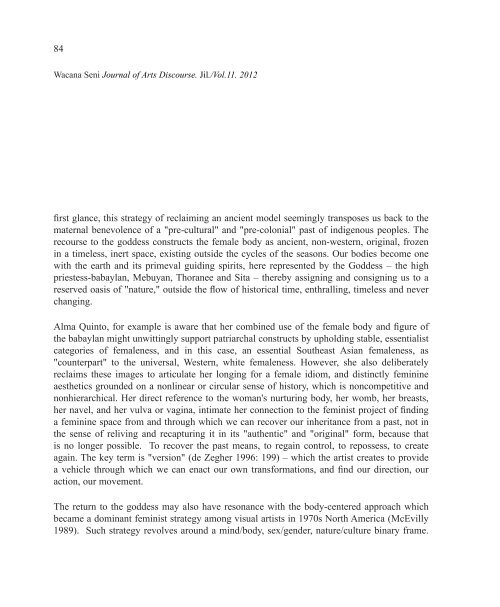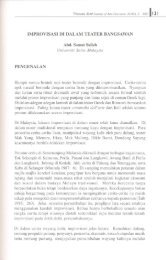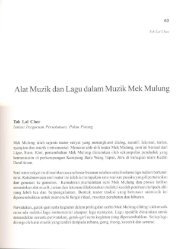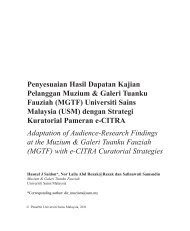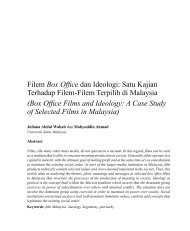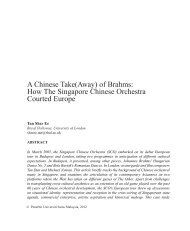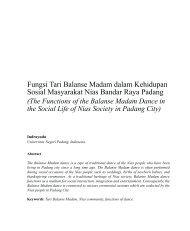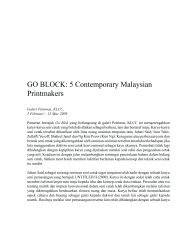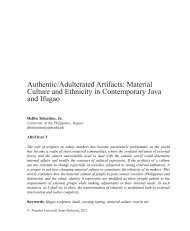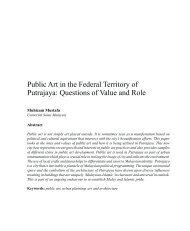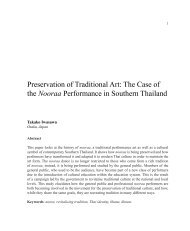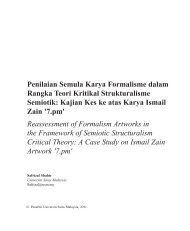Reclaiming The Healing Arts of The Ancient ... - Wacana Seni
Reclaiming The Healing Arts of The Ancient ... - Wacana Seni
Reclaiming The Healing Arts of The Ancient ... - Wacana Seni
You also want an ePaper? Increase the reach of your titles
YUMPU automatically turns print PDFs into web optimized ePapers that Google loves.
84<strong>Wacana</strong> <strong>Seni</strong> Journal <strong>of</strong> <strong>Arts</strong> Discourse. Jil./Vol.11. 2012first glance, this strategy <strong>of</strong> reclaiming an ancient model seemingly transposes us back to thematernal benevolence <strong>of</strong> a "pre-cultural" and "pre-colonial" past <strong>of</strong> indigenous peoples. <strong>The</strong>recourse to the goddess constructs the female body as ancient, non-western, original, frozenin a timeless, inert space, existing outside the cycles <strong>of</strong> the seasons. Our bodies become onewith the earth and its primeval guiding spirits, here represented by the Goddess – the highpriestess-babaylan, Mebuyan, Thoranee and Sita – thereby assigning and consigning us to areserved oasis <strong>of</strong> "nature," outside the flow <strong>of</strong> historical time, enthralling, timeless and neverchanging.Alma Quinto, for example is aware that her combined use <strong>of</strong> the female body and figure <strong>of</strong>the babaylan might unwittingly support patriarchal constructs by upholding stable, essentialistcategories <strong>of</strong> femaleness, and in this case, an essential Southeast Asian femaleness, as"counterpart" to the universal, Western, white femaleness. However, she also deliberatelyreclaims these images to articulate her longing for a female idiom, and distinctly feminineaesthetics grounded on a nonlinear or circular sense <strong>of</strong> history, which is noncompetitive andnonhierarchical. Her direct reference to the woman's nurturing body, her womb, her breasts,her navel, and her vulva or vagina, intimate her connection to the feminist project <strong>of</strong> findinga feminine space from and through which we can recover our inheritance from a past, not inthe sense <strong>of</strong> reliving and recapturing it in its "authentic" and "original" form, because thatis no longer possible. To recover the past means, to regain control, to repossess, to createagain. <strong>The</strong> key term is "version" (de Zegher 1996: 199) – which the artist creates to providea vehicle through which we can enact our own transformations, and find our direction, ouraction, our movement.<strong>The</strong> return to the goddess may also have resonance with the body-centered approach whichbecame a dominant feminist strategy among visual artists in 1970s North America (McEvilly1989). Such strategy revolves around a mind/body, sex/gender, nature/culture binary frame.


